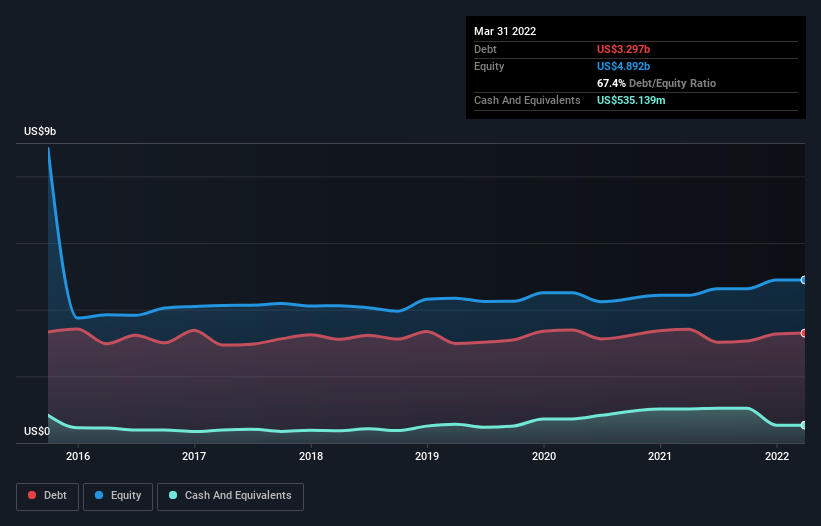Here's Why Golden Agri-Resources (SGX:E5H) Can Manage Its Debt Responsibly
Legendary fund manager Li Lu (who Charlie Munger backed) once said, 'The biggest investment risk is not the volatility of prices, but whether you will suffer a permanent loss of capital.' So it might be obvious that you need to consider debt, when you think about how risky any given stock is, because too much debt can sink a company. As with many other companies Golden Agri-Resources Ltd (SGX:E5H) makes use of debt. But is this debt a concern to shareholders?
When Is Debt Dangerous?
Debt and other liabilities become risky for a business when it cannot easily fulfill those obligations, either with free cash flow or by raising capital at an attractive price. In the worst case scenario, a company can go bankrupt if it cannot pay its creditors. However, a more usual (but still expensive) situation is where a company must dilute shareholders at a cheap share price simply to get debt under control. Of course, debt can be an important tool in businesses, particularly capital heavy businesses. The first thing to do when considering how much debt a business uses is to look at its cash and debt together.
Check out the opportunities and risks within the SG Food industry.
What Is Golden Agri-Resources's Debt?
The chart below, which you can click on for greater detail, shows that Golden Agri-Resources had US$3.08b in debt in June 2022; about the same as the year before. On the flip side, it has US$883.4m in cash leading to net debt of about US$2.20b.

How Healthy Is Golden Agri-Resources' Balance Sheet?
The latest balance sheet data shows that Golden Agri-Resources had liabilities of US$3.23b due within a year, and liabilities of US$1.92b falling due after that. Offsetting these obligations, it had cash of US$883.4m as well as receivables valued at US$852.2m due within 12 months. So its liabilities outweigh the sum of its cash and (near-term) receivables by US$3.42b.
When you consider that this deficiency exceeds the company's US$2.62b market capitalization, you might well be inclined to review the balance sheet intently. In the scenario where the company had to clean up its balance sheet quickly, it seems likely shareholders would suffer extensive dilution.
In order to size up a company's debt relative to its earnings, we calculate its net debt divided by its earnings before interest, tax, depreciation, and amortization (EBITDA) and its earnings before interest and tax (EBIT) divided by its interest expense (its interest cover). Thus we consider debt relative to earnings both with and without depreciation and amortization expenses.
With a debt to EBITDA ratio of 1.5, Golden Agri-Resources uses debt artfully but responsibly. And the fact that its trailing twelve months of EBIT was 7.7 times its interest expenses harmonizes with that theme. On top of that, Golden Agri-Resources grew its EBIT by 55% over the last twelve months, and that growth will make it easier to handle its debt. When analysing debt levels, the balance sheet is the obvious place to start. But ultimately the future profitability of the business will decide if Golden Agri-Resources can strengthen its balance sheet over time. So if you want to see what the professionals think, you might find this free report on analyst profit forecasts to be interesting.
Finally, while the tax-man may adore accounting profits, lenders only accept cold hard cash. So it's worth checking how much of that EBIT is backed by free cash flow. During the last two years, Golden Agri-Resources produced sturdy free cash flow equating to 53% of its EBIT, about what we'd expect. This free cash flow puts the company in a good position to pay down debt, when appropriate.
Our View
On our analysis Golden Agri-Resources's EBIT growth rate should signal that it won't have too much trouble with its debt. However, our other observations weren't so heartening. In particular, level of total liabilities gives us cold feet. When we consider all the factors mentioned above, we do feel a bit cautious about Golden Agri-Resources's use of debt. While we appreciate debt can enhance returns on equity, we'd suggest that shareholders keep close watch on its debt levels, lest they increase. There's no doubt that we learn most about debt from the balance sheet. However, not all investment risk resides within the balance sheet - far from it. For example Golden Agri-Resources has 3 warning signs (and 1 which is significant) we think you should know about.
If you're interested in investing in businesses that can grow profits without the burden of debt, then check out this free list of growing businesses that have net cash on the balance sheet.
New: Manage All Your Stock Portfolios in One Place
We've created the ultimate portfolio companion for stock investors, and it's free.
• Connect an unlimited number of Portfolios and see your total in one currency
• Be alerted to new Warning Signs or Risks via email or mobile
• Track the Fair Value of your stocks
Have feedback on this article? Concerned about the content? Get in touch with us directly. Alternatively, email editorial-team (at) simplywallst.com.
This article by Simply Wall St is general in nature. We provide commentary based on historical data and analyst forecasts only using an unbiased methodology and our articles are not intended to be financial advice. It does not constitute a recommendation to buy or sell any stock, and does not take account of your objectives, or your financial situation. We aim to bring you long-term focused analysis driven by fundamental data. Note that our analysis may not factor in the latest price-sensitive company announcements or qualitative material. Simply Wall St has no position in any stocks mentioned.
About SGX:E5H
Golden Agri-Resources
An investment holding company, operates as an integrated palm oil plantation company in Singapore, India, Pakistan, China, rest of Asia, the United States, Europe, and the Middle East.
Solid track record with adequate balance sheet.
Market Insights
Community Narratives




